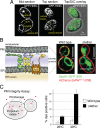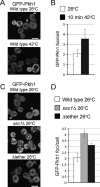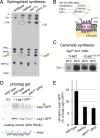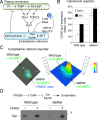Phosphoinositide kinase signaling controls ER-PM cross-talk
- PMID: 26864629
- PMCID: PMC4814223
- DOI: 10.1091/mbc.E16-01-0002
Phosphoinositide kinase signaling controls ER-PM cross-talk
Abstract
Membrane lipid dynamics must be precisely regulated for normal cellular function, and disruptions in lipid homeostasis are linked to the progression of several diseases. However, little is known about the sensory mechanisms for detecting membrane composition and how lipid metabolism is regulated in response to membrane stress. We find that phosphoinositide (PI) kinase signaling controls a conserved PDK-TORC2-Akt signaling cascade as part of a homeostasis network that allows the endoplasmic reticulum (ER) to modulate essential responses, including Ca(2+)-regulated lipid biogenesis, upon plasma membrane (PM) stress. Furthermore, loss of ER-PM junctions impairs this protective response, leading to PM integrity defects upon heat stress. Thus PI kinase-mediated ER-PM cross-talk comprises a regulatory system that ensures cellular integrity under membrane stress conditions.
© 2016 Omnus, Manford, et al. This article is distributed by The American Society for Cell Biology under license from the author(s). Two months after publication it is available to the public under an Attribution–Noncommercial–Share Alike 3.0 Unported Creative Commons License (http://creativecommons.org/licenses/by-nc-sa/3.0).
Figures







Similar articles
-
TORC2-Dependent Ypk1-Mediated Phosphorylation of Lam2/Ltc4 Disrupts Its Association with the β-Propeller Protein Laf1 at Endoplasmic Reticulum-Plasma Membrane Contact Sites in the Yeast Saccharomyces cerevisiae.Biomolecules. 2020 Nov 25;10(12):1598. doi: 10.3390/biom10121598. Biomolecules. 2020. PMID: 33255682 Free PMC article.
-
ER-to-plasma membrane tethering proteins regulate cell signaling and ER morphology.Dev Cell. 2012 Dec 11;23(6):1129-40. doi: 10.1016/j.devcel.2012.11.004. Dev Cell. 2012. PMID: 23237950
-
TOR complex 2-regulated protein kinase Ypk1 controls sterol distribution by inhibiting StARkin domain-containing proteins located at plasma membrane-endoplasmic reticulum contact sites.Mol Biol Cell. 2018 Aug 15;29(17):2128-2136. doi: 10.1091/mbc.E18-04-0229. Epub 2018 Jun 21. Mol Biol Cell. 2018. PMID: 29927351 Free PMC article.
-
GRAMD1-mediated accessible cholesterol sensing and transport.Biochim Biophys Acta Mol Cell Biol Lipids. 2021 Aug;1866(8):158957. doi: 10.1016/j.bbalip.2021.158957. Epub 2021 Apr 28. Biochim Biophys Acta Mol Cell Biol Lipids. 2021. PMID: 33932585 Review.
-
Homeostatic regulation of the PI(4,5)P2-Ca(2+) signaling system at ER-PM junctions.Biochim Biophys Acta. 2016 Aug;1861(8 Pt B):862-873. doi: 10.1016/j.bbalip.2016.02.015. Epub 2016 Feb 24. Biochim Biophys Acta. 2016. PMID: 26924250 Free PMC article. Review.
Cited by
-
Calcineurin-dependent contributions to fitness in the opportunistic pathogen Candida glabrata.mSphere. 2024 Jan 30;9(1):e0055423. doi: 10.1128/msphere.00554-23. Epub 2024 Jan 3. mSphere. 2024. PMID: 38171022 Free PMC article.
-
Sensing, Uptake and Catabolism of L-Phenylalanine During 2-Phenylethanol Biosynthesis via the Ehrlich Pathway in Saccharomyces cerevisiae.Front Microbiol. 2021 Feb 25;12:601963. doi: 10.3389/fmicb.2021.601963. eCollection 2021. Front Microbiol. 2021. PMID: 33717002 Free PMC article. Review.
-
Sticking With It: ER-PM Membrane Contact Sites as a Coordinating Nexus for Regulating Lipids and Proteins at the Cell Cortex.Front Cell Dev Biol. 2020 Jul 22;8:675. doi: 10.3389/fcell.2020.00675. eCollection 2020. Front Cell Dev Biol. 2020. PMID: 32793605 Free PMC article. Review.
-
ER-PM Contact Sites - SNARING Actors in Emerging Functions.Front Cell Dev Biol. 2021 Feb 11;9:635518. doi: 10.3389/fcell.2021.635518. eCollection 2021. Front Cell Dev Biol. 2021. PMID: 33681218 Free PMC article. Review.
-
Membrane Contact Sites in Yeast: Control Hubs of Sphingolipid Homeostasis.Membranes (Basel). 2021 Dec 9;11(12):971. doi: 10.3390/membranes11120971. Membranes (Basel). 2021. PMID: 34940472 Free PMC article. Review.
References
-
- Audhya A, Emr SD. Stt4 PI 4-kinase localizes to the plasma membrane and functions in the Pkc1-mediated MAP kinase cascade. Dev Cell. 2002;2:593–605. - PubMed
Publication types
MeSH terms
Substances
Grants and funding
LinkOut - more resources
Full Text Sources
Other Literature Sources
Research Materials
Miscellaneous

